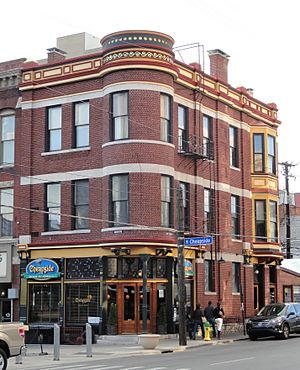Cheapside Park facts for kids
Cheapside Park was once a busy block in downtown Lexington, Kentucky. It was located between Upper Street and Mill Street. Originally called Public Square, Cheapside was the town's main marketplace in the 1800s. Before the Civil War, it was also a large market where enslaved people were sold.
Cheapside Park was a very important place in the slave trade. Many enslaved people sold here were forced to move to the southern states or work in the local area. The market was a gathering spot for slave traders, slaveholders, and others involved in this system.
Cheapside Park was later renamed Henry A. Tandy Centennial Park. This change happened because many people were unhappy with the old name's historical meaning. The park is now named after Henry A. Tandy, who was an enslaved person who later became a successful businessman. Today, it hosts the Lexington Farmers Market and popular events like Thursday Night Live.
Contents
History of Cheapside
Cheapside was a major marketplace and one of the largest markets in the South before the American Civil War. It was home to one of the biggest slave markets in the South, even though some local people disliked it. Slave traders could buy enslaved people at a low price here. This encouraged them to move the enslaved people to the "deep South" where they could sell them for more money.
For example, two slave traders, Downing and Hughes, bought 13 enslaved people for about $5,292. They spent about $257 traveling to Natchez, Mississippi to sell them. They then received about $8,695 for the sale. This meant they made a profit of about $3,144. Such large profits encouraged others to join the slave trade. Cities like Louisville, Henderson, Paducah, and Maysville became starting points for many slave traders. Their location on the Ohio River made it easy to travel to the Mississippi River and then to the more profitable slave markets in the lower South.
In 1833, the Kentucky government tried to stop or slow down the slave trade with the Non-Importation Act. This law banned bringing enslaved people into Kentucky just to sell them. The slave trade was finally outlawed in 1864. The Cheapside market itself continued until 1922, when it was officially closed.
Future President Abraham Lincoln visited his wife's family in 1846. During his visit, his father-in-law, Robert Todd, bought five enslaved people at Cheapside. Lincoln may have been there during this auction.
What "Cheapside" Means
The name "Cheapside" was first mentioned in 1813 in an advertisement for a grocery store. This store was owned by Mary Todd Lincoln's father, Robert Smith Todd. The building where the store was located is now a bourbon bar called The Bluegrass Tavern.
The word Cheapside is a common English name. It means "marketplace" and comes from an old English word, "ceapan," which means "to buy." You can often find this name in old books and stories.
The Pope Villa
Construction of the Pope Villa began in 1811. It was named after its first owners, the family of Kentucky Senator John Pope. Senator Pope bought the land for the villa to be his home.
The home was designed by Benjamin Henry Latrobe. He is often called the "father of American architecture." Latrobe also designed the U.S. Capitol Building in Washington, D.C. The Pope Villa was an important place, connected to many powerful people in American politics and business.
Today, the Bluegrass Trust owns and manages the property. They are working with the University of Kentucky History department and other researchers to offer tours of this historic site.
People Who Lived in the Pope Villa
Here is some information about important people who lived in the Pope Villa between 1811 and 1856:
John Pope
John Pope was the first owner of the Pope Villa. He was a Kentucky Senator from 1807 to 1813. He also served as Kentucky Secretary of State from 1816 to 1819. When he was not an elected official, he worked as a lawyer.
James Prentiss
James Prentiss leased the Pope Villa from John Pope in 1818. He was involved with Kentucky's first bank, the Kentucky Insurance Company of Lexington. Prentiss faced serious financial problems and left the state to avoid his debts.
William T. Barry
William T. Barry served as the U.S. Postmaster General under President Andrew Jackson from 1829 to 1835. He was the only cabinet member who did not resign after the Petticoat Affair. Barry was responsible for policies that went against people who wanted to end slavery. This included banning the famous newspaper, The Liberator.
Henry Johnson
Henry Johnson was a lawyer who often handled cases involving debts. His work sometimes included the sale of enslaved people to pay off these debts. For example, a legal document shows how he used his power to take an enslaved man named Bill and sell him to J.R. Megowan. J.R. Megowan was part of a family involved in the slave trade.
Henry Johnson's wealth grew significantly during this time. He eventually sold the Pope Villa in 1856 and moved to Mississippi, where he bought a large plantation.
Renaming Cheapside
In August 2020, Lexington's local government, the Urban County Council, voted to rename this area Henry A. Tandy Centennial Park. It was named after Henry A. Tandy, a successful businessman and community leader. His construction company laid the brick under the Courthouse's stone front.
The idea to change the name started in 2017 with a community group called "Take Back Cheapside." That same year, the council voted to remove two state-funded statues. These statues honored Confederate soldiers, Gen. John Hunt Morgan and John C. Breckinridge, who was a Confederate Secretary of War. A historical marker on the corner of Short and Upper Streets was put up by the Kappa Alpha Psi fraternity.


